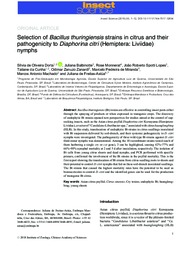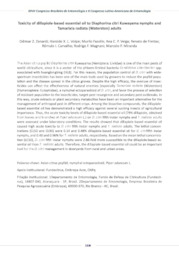Selection of Bacillus thuringiensis strains in citrus and their pathogenicity to Diaphorina citri (Hemiptera: Liviidae) nymphs.
Selection of Bacillus thuringiensis strains in citrus and their pathogenicity to Diaphorina citri (Hemiptera: Liviidae) nymphs.
Autoria: DORTA, S. de O.; BALBINOTTE, J.; MONNERAT, R.; LOPES, J. R. S.; CUNHA, T. da; ZANARDI, O. Z.; MIRANDA, M. P. de; MACHADO, M. A.; ASTUA, J. de F.
Resumo: Bacillus thuringiensis (Bt) toxins are effective in controlling insect pests either through the spraying of products or when expressed in transgenic crops. The discovery of endophytic Bt strains opened new perspectives for studies aimed at the control of sap-sucking insects, such as the Asian citrus psyllid Diaphorina citri Kuwayama (Hemiptera: Liviidae), a vector of "Candidatus Liberibacter spp.," associated with citrus huanglongbing (HLB). In this study, translocation of endophytic Bt strains in citrus seedlings inoculated with Bt suspension delivered by soil-drench, and their systemic pathogenicity to D. citri nymphs were investigated. The pathogenicity of three wild-type Bt strains against D. citri third-instar nymphs was demonstrated. Among the 10 recombinant strains tested (each of them harboring a single cry or cyt gene), 3 can be highlighted, causing 42%-77% and 66%-90% nymphal mortality at 2 and 5 d after inoculation, respectively. The isolation of Bt cells from young citrus shoots and dead nymphs, and PCR performed with specific primers, confirmed the involvement of the Bt strains in the psyllid mortality. This is the first report showing the translocation of Bt strains from citrus seedling roots to shoots and their potential to control D. citri nymphs that fed on these soil-drench inoculated seedlings. The Bt strains that caused the highest mortality rates have the potential to be used as bioinsecticides to control D. citri and the identified genes can be used for the production of transgenic Bt citrus.
Ano de publicação: 2019
Tipo de publicação: Artigo de periódico
Unidade: Embrapa Mandioca e Fruticultura
Palavras-chave: Doença de Planta, Fruta Cítrica
Observações
1 - Por padrão são exibidas publicações dos últimos 20 anos. Para encontrar publicações mais antigas, configure o filtro ano de publicação, colocando o ano a partir do qual você deseja encontrar publicações. O filtro está na coluna da esquerda na busca acima.
2 - Para ler algumas publicações da Embrapa (apenas as que estão em formato ePub), é necessário ter, no celular ou computador, um desses softwares gratuitos. Sistemas Android: Google Play Livros; IOS: iBooks; Windows e Linux: software Calibre.
Acesse outras publicações
Acesse a Base de Dados da Pesquisa Agropecuária (BDPA) para consultar o acervo completo das bibliotecas da Embrapa.



